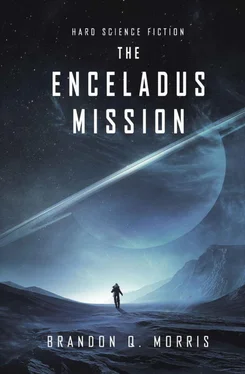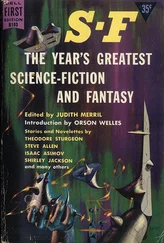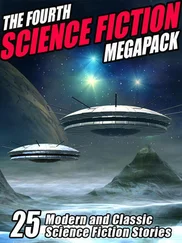The probe was 150 kilometers above the surface. The moon now covered most of its field of view. A light brown haze impeded its vision. A fierce east wind, many times stronger than winds of hurricane strength on Earth, hit the parachute and pulled it along. At an altitude of 100 kilometers, Huygens separated its main parachute and deployed the smaller stabilizing chute, as the atmosphere was now so dense the smaller one would adequately decelerate the probe. As Huygens descended, the wind gradually faded away. The haze still impeded the view downward, but the scene became clearer with each passing second. The probe was aiming for a dark brown valley located inside a lighter-colored hilly area. In its direction of travel, the instruments discovered two dark, parallel lines, like dunes on Earth, though probably many times bigger.
There was another layer of haze below Huygens . It was lit by the light of the sun, and almost looked like a fancy bed sheet covering the short mountains of Titan. The disk of the sun appeared reddish, and small—about the size of a car headlight at a distance of 150 meters. The Huygens Atmospheric Structure Instrument (HASI) analyzed the air and discovered a lot of nitrogen, some methane, and a little bit of hydrogen.
The cameras of the Descent Imager / Spectral Radiometer (DISR) saw the mountains grow below the probe as it approached its destination valley. They appeared cragged, like high mountains on Earth. Measurements showed, however, that they only rose a few hundred meters above their surroundings. There was no snow, but the mountains were made of ice. Creeks had carved themselves into their slopes, just like the meltwater rivers of the European Alps.
At an altitude of eight kilometers, the direction of the wind changed. Now it drove the chute westward. Huygens could not intervene. At 11:38 hours, the probe landed on the surface of Titan with a speed of 18 kilometers per hour. Even though it weighed almost 300 kilograms, it bounced off the surface several times due to the moon’s low gravity. Its cameras looked around. Huygens had landed in an apparently dry area that resembled a rocky desert on Earth. Around it were several fragments that looked like boulders, randomly placed as if scattered by a bored giant. Otherwise, the ground appeared to be covered by sand. Yet Huygens was not on Earth. It was cold here, very cold—minus 180 degrees. During its descent, the probe had been heated by friction, so now wisps of fog, evaporated methane, rose from the ground. The boulders were not made of granite or sandstone but of ice, just like the grains of sand on which Huygens had landed. The gas chromatograph proved the ice was impure and contained many organic compounds.
Huygens had a mission. If a probe was capable of being happy, it would be happy now. Its instruments recorded the new world around it and transmitted the results of the measurements to Cassini , just as planned.
Then, 72 minutes after touchdown, the mother probe Cassini , which sent off Huygens days ago, disappeared behind the horizon. The landing module was now completely alone. Radio telescopes on Earth would continue to receive its carrier signal for a while longer, but it could neither send nor receive data now. Huygens’ main computer was programmed to continue its monitoring routine until the batteries were completely exhausted. A quarter of an hour later, the heat sensor recorded new data. The sensor consisted of a platinum wire; it sensed a change of electrical resistance. This meant the temperature at the base of Huygens must have increased.
The computer was not supposed to interpret this event. However, its programming was flexible enough to react to unexpected occurrences. The software increased the sensitivity of other sensors in the SSP, or Surface Science Package. The Acoustic Properties Instrument (API) measured how fast sound was propagating. The Refractive Index Sensor (REF) determined the refractive index of light. The Fluid Permittivity Sensor (PER) examined the propagation of magnetic fields. All instruments agreed the properties of the soil must have changed. Had the heat on the underside of Huygens caused the ice crystals underneath it to melt? That should not worry the lander. It was able to float, as its designers wanted to be prepared for an ocean landing.
Then the accelerometer and the tilt sensor were activated—the probe had moved. The monitoring software immediately turned on the standard camera and the top camera. The perspective had changed. Reference points were no longer where they were supposed to be. The computer automatically activated the sun seeker, a detector that looked for the sun’s disk. Position data indicated Huygens has sunk by about ten centimeters, and that the probe was still sinking. The sensors of the SSP clearly determined a salty liquid, which was lighter than water, had entered the Top Hat, the measurement instrument recess at the bottom of the lander. The values told the computer that Huygens no longer stood on firm ground. Warning signals were automatically sent to Cassini to be relayed to Earth, but the mother probe Cassini was no longer in range. Now the lander should have started to float, the camera view of the surroundings ought to have steadied, and the freshly formed lake should have come within view of the camera eyes.
Yet none of these things happened. The probe sank even further. A force must have been pulling it down, one that was stronger than its buoyancy. The main computer of the lander module was not designed for countermeasures since the probe should not really be sinking. It also had no engine to provide upward thrust. The standard camera turned blind. The top camera, which faced upward, noticed how a rising wind blew orange-colored haze above the plain of ice sand. Then it, too, slid into darkness.
The other sensors continued measuring, though the results were often contradictory. The measured curves they produced made no physical sense. It must be extremely loud here. The temperatures were 200 degrees higher than expected. The conductivity for electrical and magnetic signals changed constantly. The liquid in the Top Hat was sometimes clear and then again murky. There was no natural environment these features would apply to, except maybe volcanic vents deep in the ocean, but geological activity of this kind was not expected on Titan.
The Huygens computer did not care. It was built in the 1990s. Back then, no one thought of practical artificial intelligence. It experienced neither curiosity nor fear as it was slowly pulled into the depths of this strange moon. It administered the measurements reported by the sensors and saved them in memory units that would retain them even after a loss of energy—a function that was meant for situations in which not all measurement data could be sent to Earth in one session.
Finally, the batteries of the probe failed. Eleven hours after it had been awakened, it went to sleep forever. At least that was what the ESA and NASA teams on Earth assumed, as they celebrated the landing as a great success. On the right-hand LCD display a lonely cursor still blinked, while one sensor after the other turned itself off. Its last thought was a loop that ran with a minimum of energy from a button cell, until the electrolyte of the tiny battery froze in the cold of Titan.

December 27, 2046, Enceladus
He groaned. What is wrong with me? Marchenko looked up. There was a black area where he could not see any details. Is my helmet visor smeared? He tried to wipe the visor with his hand, but he could not move his arm. Nothing happened. His brain sent the signal, but his right arm did not move. Marchenko knew what this could mean. He was a doctor, after all.
Читать дальше













